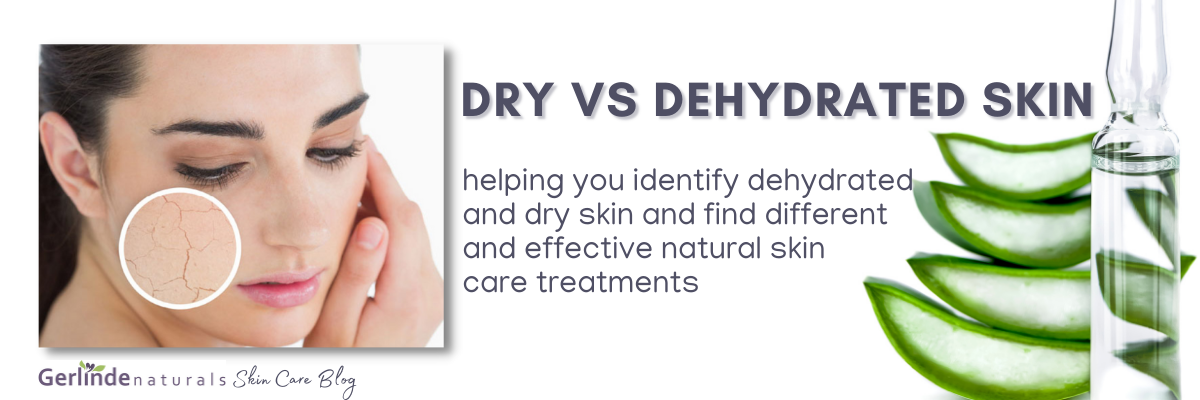Dry vs Dehydrated Skin
30 March 2022

***Dry vs Dehydrated Skin***
#1 - The Pinch Test
The first and easiest thing to do and find out if you have dehydrated skin is to perform a Pinch Test (tests the turgor or elasticity in your skin).
1. Pinch a small amount of skin on the back of your hand, under the collarbone, abdomen, chest and hold for a few seconds.
2. Release the skin and see if it "snaps" back immediately.
3. If it takes a few moments to bounce back, you are very likely dehydrated.
Please don't fret too much if you find your skin is dehydrated. There are things you can do to improve the elasticity but please be aware that we also lose skin elasticity as we age (skin will move more slowly back into place after it is pinched).
You still need to moisturise but also be aware to drink plenty, to incorporate water-rich and collagen rich foods to your diet and if possible stay away from dehydrating caffeinated drinks.
#2
1. Dry Skin is a Skin Type
2. Dehydrated Skin is considered a Condition
Dry skin is initially genetic - You are born with one of the 4 main skin types which change with age and seasons. Dry skin can sometimes also be caused by underlying health conditions (medicines), vitamin deficiencies or hormonal change or can be associated with eczema, rosacea. When you have dry skin, your sebaceous glands don't produce enough oil.
Dehydration is usually caused by external factors and means that your body is losing more water than it’s taking in. Aside from not drinking enough water, this can be related to increased urination from caffeine or diuretics. It may also occur from lots of sweating from exercise and is usually only a temporary condition. Oily skin can be dehydrated too and can be more prone to breakouts.
Dehydration is usually caused by external factors and means that your body is losing more water than it’s taking in. Aside from not drinking enough water, this can be related to increased urination from caffeine or diuretics. It may also occur from lots of sweating from exercise and is usually only a temporary condition. Oily skin can be dehydrated too and can be more prone to breakouts.
#3
Signs of Dry Skin
Signs of Dehydrated Skin
Like I already mentioned in TIP #2 Dry Skin changes with age and seasons. It may also be caused if you
- are residing in a dry climate
- come into contact with chlorine in a swimming pool
- excessive sun exposure
- are exposed to wind or cold
- use harsh foaming cleansing products
- take frequent long, hot showers or baths
- come into contact with an irritant or allergen
- have underlying health conditions (as mentioned above)
- are going through hormonal changes (as mentioned above)
- have dermatitis, eczema, rosacea (as mentioned above)
Signs of Dry skin can be
- Scaling
- Peeling
- White flakes
- Redness
- Tightness
- Irritation / Itchiness
- Looks and feels rough (like sandpaper)
- lacking plumpness
- Fine Lines
Signs of Dehydrated Skin can be
- Dullness
- Under eye circles
- Sunken eyes
- Prone to breakouts
- Itchiness
- More noticeable fine lines
- Absorbs products very quickly / foundation vanishes or goes patchy
- Dehydration is usually caused by external factors and means that your body is losing more water than it’s taking in (see more in Tip #2)
#4
Different Treatments for Dry and Dehydrated Skin
If you want your skin to look and feel its best, you need to both hydrate and moisturise. However, those with dehydrated skin may be able to skip moisturisers while dry skin types may find their skin getting worse by only hydrating.
If you are hydrating and moisturising, use hydrating ingredients first and then take the steps necessary to seal that moisture in.
For dehydrated skin, oral hydration is a must because it’s adding water into complexion from the inside. You can also incorporate water-rich foods into your diet and if possible, carry around a water mist.
For dry skin, keep on moisturising. This process helps dry skin better retain water and maintain a proper level of hydration. The key to addressing dry skin is finding products that help you lock in moisture, especially overnight. Try using a humidifier, especially during winter months. Avoid hot showers!
Other ingredients to use for Dry Skin:
Plant Oils, Face Oils, Butters (ie Shea Butter), Ceramides, Humectants (ie Hyaluronic Acid)
Other ingredients to use for Dehydrated Skin:
Humectants like Hyaluronic Acid, Glycerine, Lactic Acid, Ceramides, Panthenol, Aloe Vera
A good basic skin care routine for dry skin could look like this →
First of all, NO foaming cleansing products please. They are far too harsh and drying. Don't rub your skin with flannels, ie when taking a cleanser off - be gentle.
- Use a good basic *Cream Cleanser
- *Alcohol free Toner with Aloe Vera, Pro Vitamin B5, Glycerine - spray on and leave!
- Serum - look for products that use the term "barrier repair" with ceramides, Hyaluronic Acid and/or amino acids
- Moisturiser - if your skin feels as dry as the desert, try a *thicker cream. If it feels it's lacking water (feels less juicy), use *a lighter cream with Hyaluronic acid. Use a Balm or Face Oil afterwards to lock in moisture, ie -->
- Face Oil - a good basic *Face Oil. You could use a natural oil mix like Jojoba / Squalane / Avocado Oil to nourish the dry skin. Works a charm.
- Retinols twice a week at night time - if your skin is very sensitive use a natural Retinol alternative such us my *Revive Elixir with Cacay Oil or try Bakuchiol
*linked product suggestions